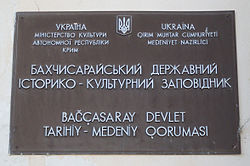Crimean Tatar language
Crimean Tatar has been extensively influenced by nearby Oghuz dialects and is also mutually intelligible with them to varying degrees.
[7][8] However, according to the Institute of Oriental Studies, due to negative situations, the real degree of threat has elevated to critically endangered languages in recent years, which are highly likely to face extinction in the coming generations.
Approximately 120,000 reside in Central Asia (mainly in Uzbekistan), where their ancestors had been deported in 1944 during World War II by the Soviet Union.
Turkey has provided support to Ukraine, to aid in bringing the schools teaching in Crimean Tatar to a modern state.
[14] An estimated 5 million people of Crimean origin live in Turkey, descendants of those who emigrated in the 19th and early 20th centuries.
[16] Almost all Crimean Tatars are bilingual or multilingual, using the dominant languages of their respective home countries, such as Russian, Turkish, Romanian, Uzbek, Bulgarian or Ukrainian.
In 1876, the different Turkic Crimean dialects were made into a uniform written language by Ismail Gasprinski.
A preference was given to the Oghuz dialect of the Yalıboylus, in order to not break the link between the Crimeans and the Turks of the Ottoman Empire.
During the 1990s and 2000s, the government of the Autonomous Republic of Crimea under Ukraine encouraged replacing the script with a Latin version again, but the Cyrillic has still been widely used (mainly in published literature, newspapers and education).
In the Russian-annexed "Republic of Crimea" all official communications and education in Crimean Tatar are conducted exclusively in the Cyrillic alphabet.
[19] Because high vowels in Crimean Tatar are short and reduced, /i/ and /ɯ/ are realized close to [ɪ], even though they are phonologically distinct.
[22] At the same time the southern and some central dialects preserve glottal /h/ which is pronounced /x/ in the standard language.
The grammar of Crimean Tatar, like all Turkic languages, is agglutinating,[23] with the exclusive use of suffixing to express grammatical categories.
[24] Generally, suffixes are attached to the ends of word stems, although derivational morphology makes uses of compounding as well.
[27] Crimean Tatar, like most Turkic languages, features pervasive vowel harmony, which results in sound changes when suffixes are added to verb or noun stems.
[28] Using the transliteration system in Kavitskaya (2010), non-high vowels undergoing backness harmony vary between [a] and [e], and are represented as A.
High vowels that undergo both backness and rounding harmony alternate between [i], [y], [ɪ] and [u] and are represented as I.
[31] Crimean Tatar verbal morphology is fairly complex, inflecting for tense, number, person, aspect, mood and voice.
[43] язылгъанyazılğanwrite-PTCP.PASTмектюпmektüpletterязылгъан мектюпyazılğan mektüpwrite-PTCP.PAST letter"written letter"сынаджакъsınacaqbreak-PTCP.FUTарабаarabacartсынаджакъ арабаsınacaq arababreak-PTCP.FUT cart"cart that will break"янарyanarburn-PTCP.PRESдагъdağforestянар дагъyanar dağburn-PTCP.PRES forest"burning forest"Copula The copula ol ("to be, become, exist") is generally expressed as a predicate suffix in the present tense, closely resembling the pronominal person endings, as displayed below.
[45] Thus: AcaнAsanAsanэвгeevgehouse-DATкeлипkelipcome-CVB.PASTэвниevnihouse-ACCтемизледи.temizledi.clean-VB-PASTAcaн эвгe кeлип эвни темизледи.Asan evge kelip evni temizledi.Asan house-DAT come-CVB.PAST house-ACC clean-VB-PAST"Asan came home and cleaned the house.
"Crimean Tatar noun stems take suffixes which express grammatical number, case and possession.
Of the two, kendi- is more common in the southern dialect, but both are used throughout the entire area in which Crimean Tatar is spoken.
[57] SUF:adjectival suffix кескинkeskincut-SUFкескинkeskincut-SUF"sharp"кюндекиkündekiday-SUFкюндекиkündekiday-SUF"daily"КъырымлыQırımlıCrimea-SUFКъырымлыQırımlıCrimea-SUF"Crimean"The comparative and superlative forms of adjectives are expressed, respectively, by the suffix -ÇA and the particle eñ,[56] as in the following examples: узунджурuzuncurузунджурuzuncur"hotter"энъeñбалабанbalabanэнъ балабанeñ balaban"biggest"An idiomatic superlative form using episi ("all") in the ablative case is also possible.
[18] However there are some contradictions to the decision: virtually all Finnic languages, including distantly-related Skolt Sámi, spoken in Russia, however, currently use the Latin script as their sister languages Finnish and Estonian do, despite the historical existence of Karelian Cyrillic alphabet.
However, in 2021, the Ministry of Reintegration of Temporarily Occupied Territories of Ukraine has announced it begins the implementation of the decision, with vice premier Oleksii Reznikov supporting the transition by stating that Latin corresponds better to Turkic phonetics.
The ministry revealed it plans to finish the transition to Latin by 2025, which was supported by the Mejlis of the Crimean Tatar People.



